Horses have some parts that are similar to ours, such as eyes, ears, mouth, and legs, but there are also some parts that may sound strange to those who are new to horses.
Horse body parts are also known as points of the horse or external anatomy, which are the visible external features, for example the neck and tail.
However, some parts of the skeleton and superficial muscle, such as the facial crest and jugular groove, are also considered points of the horse.
In this article, we will explore the importance of knowing horse anatomy, provide a detailed overview of external horse body parts, and discuss some of the the uses and functions of different horse components.
To make this journey even more engaging, we’ll throw in some fun trivia and address frequently asked questions related to the parts of the horse.
So, let’s dive in and expand our knowledge of these magnificent animals together!
Table of Contents
Why Is It Important To Know The Anatomy Of Your Horse?
As a horse owner, rider, or trainer, understanding the different parts of a horse and their functions can really make a difference in the horse’s health, well-being, and performance.
Learning the parts of the horse helps you:
- Monitor your horse’s health more effectively
- Communicate more accurately about horses with professionals
- Develop better riding and training techniques
- Fit tack correctly
- Understand conformation
- Make informed decisions related to your horse’s care and management
It is an essential part of horse ownership and horse care responsibility to know the parts of the horse.
Improved Horse Care
A solid grasp of horse anatomy allows you to monitor your horse’s health more effectively.
Recognizing the normal appearance and function of each body part helps you identify potential issues early on, such as injuries, swelling, or changes in gait.
Early detection can lead to prompt treatment, reducing the risk of long-term problems and improving the horse’s overall well-being.
Enhanced Communication with Professionals
Knowing the names of a horse’s body parts is important for several reasons.
Firstly, it allows riders and horse owners to describe a horse’s conformation or the location of an injury.
This knowledge is essential when communicating with vets, farriers, trainers, and other equine professionals.
By understanding the correct terminology and the functions of different body parts, you can communicate more efficiently and accurately about areas of concern and other important information.
Better Riding and Training Techniques
Understanding equine anatomy can make someone a better rider because knowing anatomy is what allows us to understand and eventually influence the horse’s movement.
For instance, a rider who understands how the horse’s neck and back work together can develop exercises and riding strategies tailored to their horse’s needs.
This customized approach can lead to more successful training, improved performance, and a stronger bond between you and your horse.
Proper Tack Fitting
Familiarity with your horse’s anatomy is crucial for selecting and fitting tack correctly.
Ill-fitting tack can cause discomfort, restrict movement, and lead to injuries.
By understanding the various parts of your horse’s body and their functions, you can make informed decisions when choosing equipment, ensuring optimal comfort and performance.
Understanding Conformation
Another important reason to know the anatomy of a horse is to understand its conformation.
Conformation refers to the physical structure of the horse and how its body parts fit together.
Knowing the parts of a horse’s body and their functions can help you understand the horse’s conformation and how it may affect its performance.
For example, a horse with a long, sloping shoulder is often considered desirable because it allows for a longer stride and smoother movement.
Similarly, a horse with a short, upright pastern may be more prone to injury.
Understanding conformation can help you choose a horse that is suited to your riding discipline, develop a training plan that takes conformation into account, and even identify potential issues early on.
Informed Decision Making
Knowing horse anatomy can help you identify potential problems and make informed decisions related to your horse’s care and management.
Whether you’re considering a new training regimen, adjusting your horse’s diet, or evaluating its living environment, a comprehensive knowledge of anatomy can help you make choices that best support your horse’s health and well-being.
Horse Diagram
Here is a diagram of the points of the horse.
It has most of the points that I will be going over below but not all of them.
The parts of the horse you see labelled in the diagram are the most commonly used.
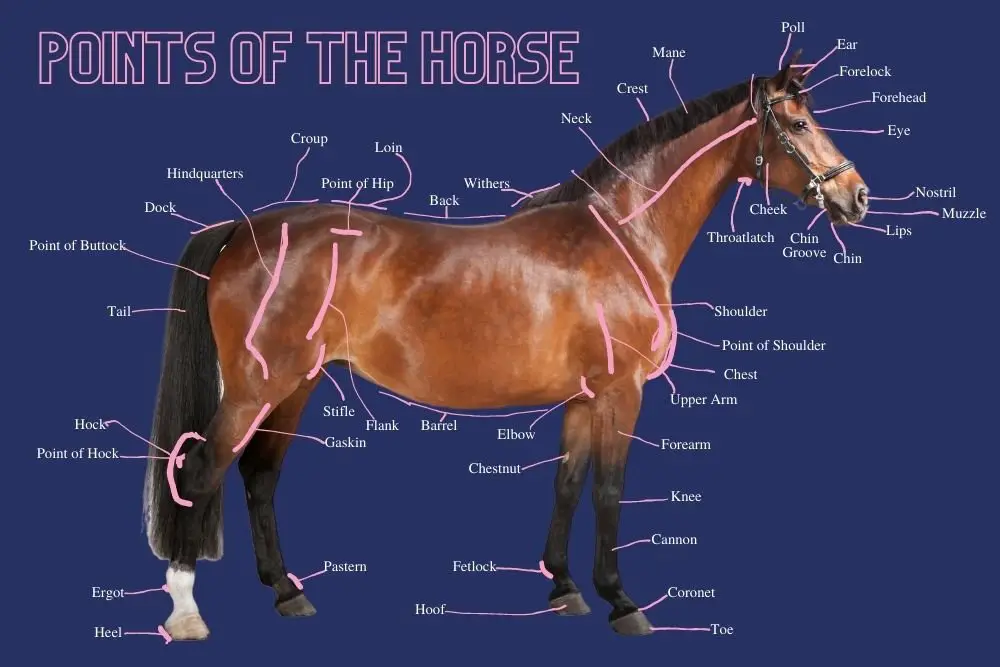
Description Of The Parts Of The Horse
The external anatomy of a horse consists of numerous parts that are vital for the animal’s function, performance, and overall health.
Understanding the various parts of a horse can provide valuable insights into their anatomy, health, and even their behavior.
In this section, we will explore each part of the horse, along with a brief description of their location as well as their function.
Detailed explanation of each external part of the horse
| Point Of Horse | Location On Horse | Function |
|---|---|---|
| Arm | The upper front leg of the horse, which connects the shoulder to the elbow. | Provides support and allows for movement in the front leg. |
| Back | The area between the withers and the loin, where the saddle sits. | Supports the rider and distributes the weight of the saddle. |
| Barrel | The horse’s torso, containing the ribcage and vital organs. | Provides protection for vital organs and contributes to respiration. |
| Belly | The underside of the horse, between the ribcage and the hindquarters. | Supports the horse’s abdomen and aids in digestion. |
| Branches of Jaw | The two sides of the lower jawbone, also known as the mandible. | Allows for chewing and swallowing. |
| Brisket | The area between the horse’s front legs, just below the chest. | Supports the front limbs and chest. |
| Buttock | The muscular area of the hindquarters behind the hip and above the thigh. | Provides power and propulsion during movement. |
| Cannon or cannon bone | The long, straight bone between the knee or hock and the fetlock joint. | Provides support and stability during movement. |
| Cheek or Jowl | The fleshy area on the side of the horse’s face, extending from the corner of the mouth to the jawline. | Contains facial muscles and salivary glands for chewing and swallowing. |
| Chest or Breast | The broad, muscular area on the front of the horse, between the forelegs. | Houses pectoral muscles for supporting front limbs and balance. |
| Chestnut | A small, callus-like growth found on the inside of the horse’s leg above the knee or below the hock. | Vestigial structure with no known function in modern horses. |
| Chin | The lower part of the horse’s face, below the lower lip. | Supports the lower jaw and aids in chewing and swallowing. |
| Chin groove | The area that dips in, beneath the lower jaw where the curb chain of a bit rests. | Provides a place for the curb chain of a bit to rest during riding. |
| Coupling | The area where the horse’s barrel meets the hindquarters, also known as the loin. | Connects the barrel to the hindquarters and allows for flexibility. |
| Coronet or coronary band | The band of soft tissue at the top of the hoof where hair meets the hoof wall. | Produces the hoof wall and provides a cushion for the hoof. |
| Crest | The upper, curved part of the horse’s neck where the mane grows. | Provides attachment for the mane and aids in head and neck movement. |
| Croup | The top of the horse’s hindquarters, extending from the loin to the base of the tail. | Provides support for the dock and tail and contributes to propulsion. |
| Dock | The base of the horse’s tail, consisting of the first few tailbone vertebrae. | Supports the tail and allows for tail movement. |
| Ears | The two structures on the top of the horse’s head that are responsible for hearing. | Allows the horse to hear and detect sounds in its environment. |
| Eyes | The two organs on the sides of the horse’s face that are responsible for vision. | Allows the horse to see and detect objects in its environment. |
| Elbow | The joint connecting the upper front leg (arm) and the forearm. | Allows for bending and flexing of the front leg during movement. |
| Ergot | A small, horn-like growth found on the back of the fetlock joint. | Vestigial structure with no known function in modern horses. |
| Face | The front of the horse’s head, including the forehead, eyes, and muzzle. | Contains the eyes, muzzle, and other facial features for sensory input. |
| Fetlock | The joint between the cannon bone and pastern, resembling an ankle. | Provides shock absorption and flexibility during movement. |
| Flank | The area between the ribcage and the hindquarters, just behind the girth. | Provides a connection between the barrel and the hindquarters. |
| Flexor Tendon | The thick, elastic tissue that connects the muscles in the lower leg to the bones, allowing the horse to flex its joints. | Facilitates joint movement and provides stability during movement. |
| Forearm | The muscular portion of the front leg between the elbow and the knee. | Provides strength and support for the front leg during movement. |
| Forehead | The upper part of the horse’s face between the eyes. | Houses the frontal sinuses and contributes to the horse’s facial structure. |
| Forelock | The hair that grows from the horse’s poll and falls between the ears and onto the forehead. | Provides protection from insects and debris. |
| Frog | The V-shaped, rubbery structure on the underside of the hoof that provides traction and shock absorption. | Supports and cushions the hoof during movement. |
| Gaskin | The muscular portion of the hind leg between the stifle and the hock. | Provides strength and support for the hind leg during movement. |
| Girth or heart girth | The measurement around the horse’s barrel, just behind the elbow, used to determine the proper saddle size. | Area used to secure the saddle and measure the horse’s size for equipment. |
| Hindquarters | The muscular rear portion of the horse, including the buttock, thigh, gaskin, and hock. | Provides power and propulsion during movement. |
| Hock | The large, angular joint of the hind leg, similar to the human ankle. | Provides support and flexibility during movement. |
| Hoof | The hard, protective outer covering of the horse’s foot, made of keratin. | Provides protection and support for the horse’s foot. |
| Jugular groove | The shallow groove on either side of the horse’s neck where the jugular vein is located. | Allows for blood flow to and from the head and provides a location for veterinary procedures. |
| Knee | The joint in the front leg that connects the forearm and the cannon bone. | Provides support and flexibility during movement. |
| Loin | The area between the back and the croup, also known as the coupling. | Connects the back to the croup and allows for flexibility. |
| Lower Lip | The soft, fleshy part of the horse’s mouth, above the chin. | Facilitates chewing, swallowing, and lip movement. |
| Mane | The long hair that grows from the horse’s crest and falls onto the neck. | Provides protection from insects and debris, and used for grooming. |
| Muzzle | The soft, fleshy area surrounding the horse’s nostrils and mouth. | Allows for respiration, grazing, and sensory input. |
| Nose or Bridge of Nose | The top, bony part of the horse’s muzzle. | Provides structure for the horse’s muzzle and supports the nostrils. |
| Nostril | The two openings in the horse’s muzzle that are responsible for respiration. | Allows the horse to breathe and detect scents in its environment. |
| Occipital Crest | The ridge on the back of the horse’s skull, between the ears. | Provides attachment for neck muscles and contributes to the horse’s skull structure. |
| Pastern | The sloping part of the horse’s leg between the fetlock and the hoof. | Provides shock absorption and flexibility during movement. |
| Point of Shoulder | The bony protrusion at the front of the horse’s chest where the scapula meets the humerus. | A reference point for measuring the horse’s conformation and shoulder angle. |
| Point of Hip | The bony protrusion at the top of the horse’s hindquarters, near the base of the spine. | A reference point for measuring the horse’s conformation and hip angle. |
| Point of Buttock | The outermost part of the horse’s hindquarters, formed by the ischium bone. | A reference point for measuring the horse’s conformation and hindquarter angle. |
| Point of Hock | The bony protrusion on the back of the hock joint. | A reference point for measuring the horse’s conformation and hock angle. |
| Poll | The top of the horse’s head, located between the ears. | Provides attachment for the forelock and supports the horse’s skull. |
| Ribs | The curved bones that form the ribcage, protecting the horse’s vital organs. | Provides protection for vital organs and contributes to respiration. |
| Root of the tail or root of the dock | The base of the tail where it attaches to the horse’s body. | Provides attachment for the tail and supports the tailbone. |
| Shoulder | The sloping area of the horse’s front leg between the withers and the point of the shoulder. | Provides strength and support for the front leg during movement. |
| Splints | Small bones found between the cannon bone and the splint bones, which can become inflamed and cause swelling. | Provides support and protection for the horse’s lower leg. |
| Stifle joint | The large, complex joint in the hind leg, equivalent to the human knee. | Provides support and flexibility during movement. |
| Suspensory Ligament | A strong, fibrous tissue that supports the fetlock joint and helps absorb shock during movement. | Provides support and stability for the fetlock joint during movement. |
| Tail | The long, flowing hair that grows from the base of the horse’s spine and provides balance and communication. | Used for balance, communication, and protection from insects and debris. |
| Thigh | The muscular upper portion of the horse’s hind leg between the hip and the stifle joint. | Provides strength and support for the hind leg during movement. |
| Throatlatch | The area under the horse’s jaw where the head and neck meet, used to secure the bridle | Provides a secure location for the bridle and allows for head and neck movement. |
| Throttle | The part of the horse’s neck just below the throatlatch, where the trachea and esophagus pass through. | Houses the trachea and esophagus, allowing for respiration and swallowing. |
| Trapezium | The area where the horse’s neck, withers, and back meet, forming a trapezoid shape. | Provides a connection between the horse’s neck, withers, and back for stability and movement. |
| Withers | The highest point on the horse’s back, formed by the tops of the shoulder blades. | Provides a reference point for saddle fitting and measuring the horse’s height. |
Uses Of The Horse’s Body
There are various functions of the horse’s different body parts.
Here are a few of their uses:
- Locomotion and Movement
- Communication and Expression
- Health and Well-being
- Reproduction
- Rider Support and Balance
To further enhance your understanding of horse anatomy, lets go over the different areas of the horses body.
The Different Areas Of The Horse’s Body
I think you are starting to see that it is crucial for you as horse owner, rider, or trainer, to understand the various parts of the horse’s anatomy.
Here we are going to explore the different body areas of the horse and their components.
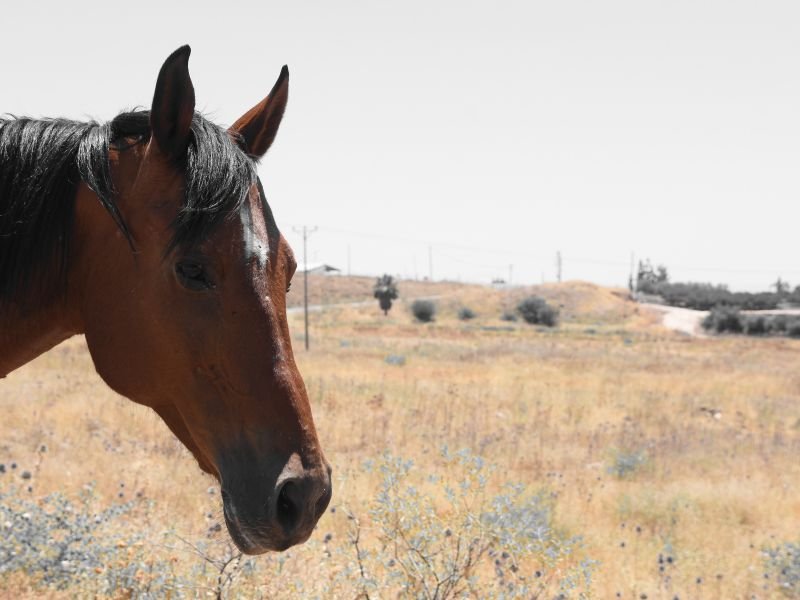
The Head
The head of a horse includes vital sensory organs such as the eyes, ears, and nose, as well as the mouth for eating and communication.
The head is connected to the neck at the poll and houses the brain, which controls the horse’s behavior and responses to stimuli.
Key components of the head include the forehead, face, muzzle, and chin groove.
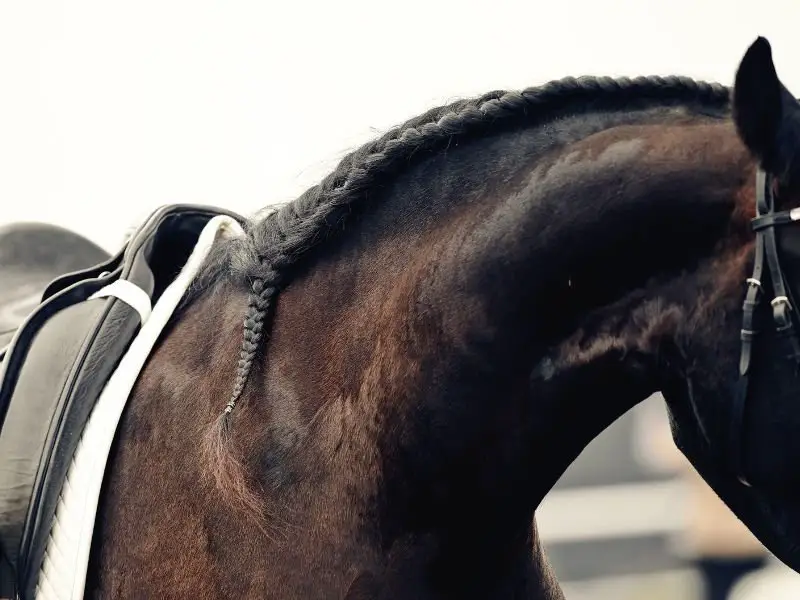
The Neck
The neck of a horse serves as a connection between the head and the body, allowing for flexibility and movement.
It contains vital structures like the jugular groove and throatlatch.
The neck is composed of vertebrae, muscles, and ligaments that provide support, balance, and range of motion, enabling the horse to graze, communicate, and carry a rider.
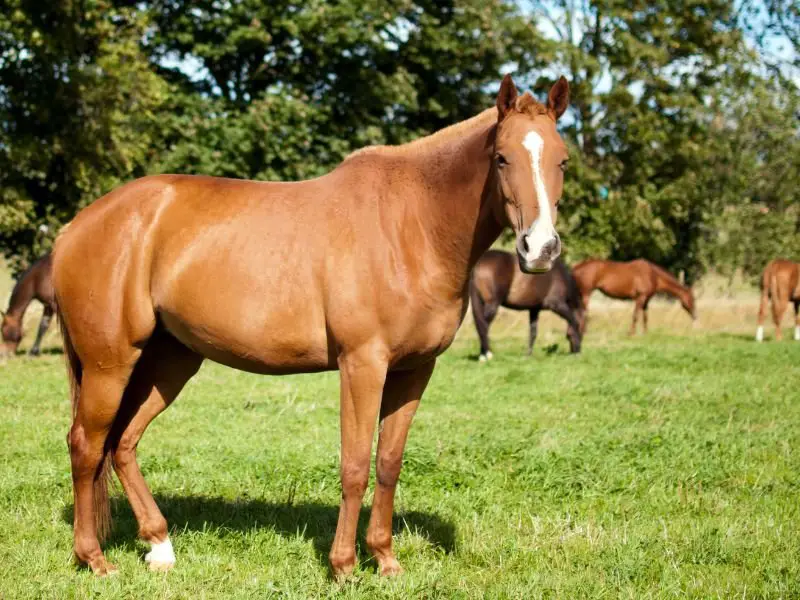
The Body
The horse’s body comprises the withers, back, loin, barrel, chest, and croup.
These areas house essential organs such as the heart, lungs, and digestive system.
The body of the horse is supported by a strong skeletal system and wrapped in layers of muscle that provide power, strength, and flexibility for various activities.
This includes running, jumping, and carrying a rider.
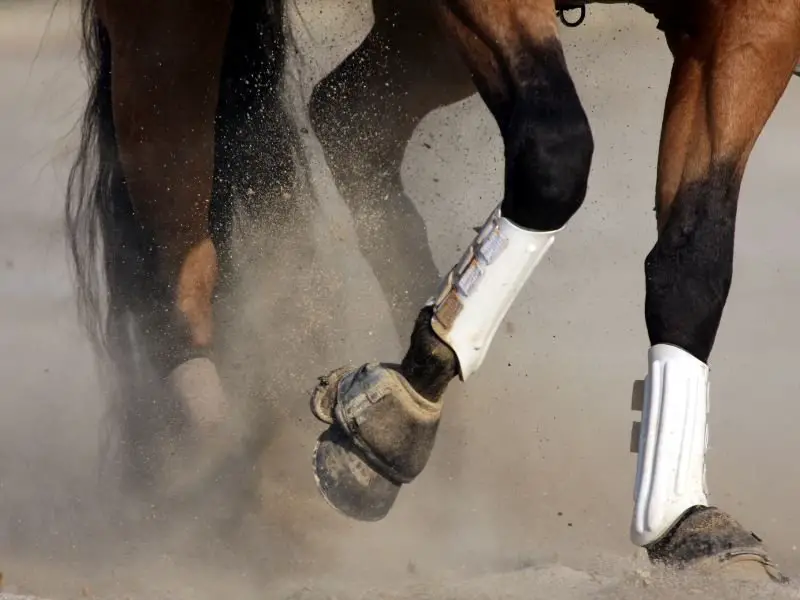
The Legs
The legs of a horse are comprised of the forelegs and hind legs, each with a unique structure and function.
The forelegs bear the majority of the horse’s weight, while the hind legs generate the propulsion necessary for movement.
The legs consist of bones, joints, tendons, and ligaments that work together to support the horse’s weight and facilitate movement.
Key parts of the horse’s legs include the shoulder, arm, knee, cannon bone, fetlock, pastern, and hoof.
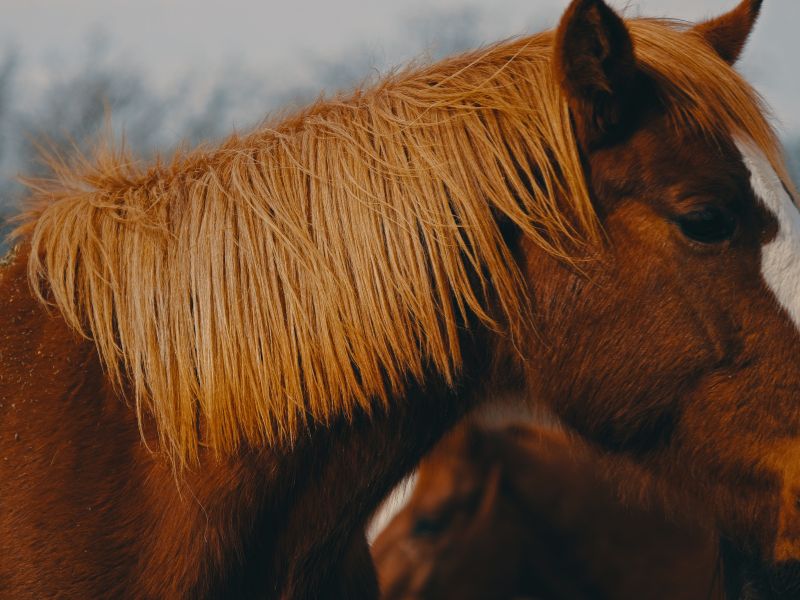
The Mane
The mane is the long hair growing along the top of the horse’s neck, from the poll down to the withers.
It serves several functions, including providing insulation from the weather and protection from insects.
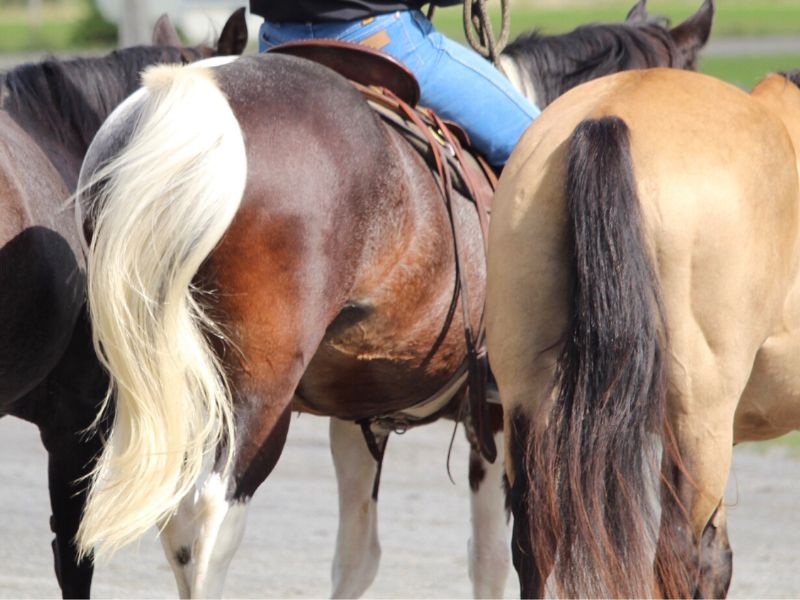
The Tail
The tail of a horse consists of a base called the dock and a long, flowing section of hair known as the tailbone.
The tail serves multiple purposes, including swatting away insects, as well as providing balance and stability during movement.
The tail also plays a role in communication, as horses may raise or lower their tails to signal different emotions.
Additionally, the tail can help to protect the sensitive area around the horse’s anus and genitals.
Parts Of The Horse Quiz
Fun And Interactive Trivia. Test Your Knowledge!
FAQ About The Parts Of The Horse
What is the poll of a horse?
The poll is the bony protrusion at the top of the horse’s head, just behind the ears. It is the highest point of the horse’s head and is an important reference point for measuring the horse’s height.
What are the withers of a horse?
The withers are the bony protrusions at the base of the horse’s neck, where the neck and back meet. They are an important reference point for measuring the horse’s height and for saddle fitting.
What is the fetlock of a horse?
The withers are the bony protrusions at the base of the horse’s neck, where the neck and back meet. They are an important reference point for measuring the horse’s height and for saddle fitting.
What is the gaskin of a horse?
The gaskin is the muscular area of the hind leg, between the stifle and the hock.
What is the frog of a horse’s hoof?
The frog is the V-shaped cushioned pad on the underside of the horse’s hoof. It helps absorb shock and provides traction.
What are the ergots of a horse’s leg?
The ergots are small horny growths on the back of the horse’s fetlock, above the hoof. They are vestigial remnants of the horse’s evolutionary history and have no known function.
What is the croup of a horse?
The croup is the muscular area of the horse’s hindquarters, between the loins and the tail.
What is the coronary band of a horse’s hoof?
The coronary band is the area of skin at the top of the horse’s hoof, where the hoof wall meets the skin. It is where new hoof growth originates.
What is the forelock of a horse?
The forelock is the long strand of hair that falls over the horse’s forehead, between the ears. It is primarily for aesthetic purposes but can also help keep sweat out of the horse’s eyes.
What is the dock of a horse’s tail?
The dock is the bony base of the horse’s tail, where the tailbone is located. It is an important reference point for assessing the horse’s overall conformation.
u003cstrongu003eWhat is the most sensitive part of a horse?u003c/strongu003e
The most sensitive part of a horse varies among individual horses, but common sensitive areas include the poll, muzzle, and flank.
u003cstrongu003eWhat is the hair on a horse’s neck called?u003c/strongu003e
The hair on a horse’s neck is called the mane.
u003cstrongu003eWhat is a horse’s ankle called?u003c/strongu003e
The horse’s ankle is called the fetlock, which is the joint between the cannon bone and pastern.
u003cstrongu003eWhat is the extra toe on a horse called?u003c/strongu003e
Horses do not have an extra toe. However, some people who believe in the theory of evolution, think that the splint bones in the horse’s legs are remnants of extra toes. The splint bone is located on the inside area of the cannon bone.
u003cstrongu003eWhat is the horse wrist called?u003c/strongu003e
The horse’s wrist is equivalent to the knee in the front leg and the stifle joint in the hind leg.
The horse’s wrist is equivalent to the knee in the front leg and the stifle joint in the hind leg.
The four legs of a horse are simply called legs. But more specifically the front legs are called the forelegs and the back legs are called the hind legs.
Conclusion
In conclusion, this blog post has given you a thorough look at the different parts of a horse, including the head, neck, body, legs, mane, and tail.
As you’ve seen, each part has a unique function and plays a significant role in your horse’s overall health and performance.
It’s essential for horse owners, riders, and trainers to truly understand their horse’s anatomy. This knowledge not only helps you identify and address potential problems but also assists in preventing future issues.
So, take the time to learn about each part of your horse’s body and how it works. And remember, whenever you have any concerns or questions, don’t hesitate to consult with a veterinarian or equine professional.
By doing so, you’ll be better prepared to care for your horse, leading to a deeper bond and a more rewarding experience with your equine friend.
Now that you have a better understanding of the external anatomy of a horse, you’ll be able to communicate more effectively with your veterinarian and better care for your horse’s health.
Cheers, Kacey
P.S. Did you like this article? Gallop over to:

